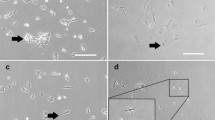Abstract
Some studies have been carried out to analyze human female first meiotic prophase. Most of them use samples from foetuses collected after legal interruption of pregnancy. In some cases, a control population is needed and foetuses aborted for non-chromosomal reasons are used. The assumption of these samples as being euploids could perhaps represent an error. In this article, we describe an easy methodology to certify the euploidy of foetal ovarian tissue using an one-week somatic culture. Using this protocol, we have obtained a primary culture in 88.2% of the studied cases, material usable for being karyotyped in 93.3% of the cases, and a cytogenetic diagnosis was performed in 100% of these cases. Finding the same karyotype in cultured cells in cases in which we had a prenatal cytogenetic diagnosis has validated the technique, and in applying this protocol we have been able to check our prophase meiotic-study control population.
Similar content being viewed by others
References
Barlow A.L. and Hultén M.A. 1997a. Combined immunocytogenetic and molecular cytogenetic analysis of meiosis I oocytes from normal human females. Zygote 6: 27–38.
Barlow A.L. and Hultén M.A. 1997b. Sequential immunocytogenetics, molecular cytogenetics and transmission electron microscopy of microspread meiosis I oocytes from a human fetal carrier of an unbalanced translocation. Chromosoma 106:293–303.
Barlow A.L. and Hultén M.A. 1998. Crossing over analysis at pachytene in man. Eur J Hum Genet 6: 350–358.
Bugge M., Collins A., Petersen M.B., Fisher J., Brandt C. and Hertz J.M. et al. 1998. Non-disjunction of chromosome 18. Hum Mol Genet 7: 661–669.
Cheng E.Y., ChenY.J., Bonnet G. and Gartler S.M. 1998. Cytogenet Cell Genet 80: 48–53.
Cheng E.Y., Chen Y.J., Disteche C.M. and Gartler S.M. 1999. Analysis of a paracentric inversion in human oocytes: non-homologous pairing in pachytene. Hum Genet 105: 191–196.
Cheng E.Y., Chen Y.J. and Gartler S.M. 1995. Chromosome painting analysis of early oogenesis in human trisomy 18. Cytogenet Cell Genet 70: 205–210.
Cheng E.Y. and Gartler S.M. 1994. A fluorescent in situ hybridization analysis of X chromosome pairing in early human female meiosis. Hum Genet 94: 389–394.
Eggermann T., Nörthen M.M., Eiben B., Hofmann D., Hinkel K. and Fimmers R. et al. 1996. Trisomy of human chromosome 18: molecular studies on parental origin and cell stage of nondisjunction. Hum Genet 97: 218–223.
Fisher J.M., Harvey J.F., Morton N.E. and Jacobs P.A. 1995. Trisomy 18: studies of the parental and cell division of origin and the effect of aberrant recombination on nondisjunction. Am J Hum Genet 56: 669–675.
Garcia M., Dietrich M., Freixa L., Vink A.C.G., Ponsa M. and Egozcue J. 1987. Development of the first meiotic prophase stages in human fetal oocytes observed by light microscopy. Hum Genet 77: 223–232.
Garcia M., Dietrich M., Pujol R. and Egozcue J. 1989. Nucleolar structures in chromosome and SC preparations from human oocytes at 1st meiotic prophase. Hum Genet 82: 147–153.
Hansmann I. and Probeck H.D. 1979. The induction of non-disjunction by irradiation in mammalian oogenesis and spermatogenesis. Mutat Res 61: 69–76.
Hartshorne G.M., Barlow A.L., Child T.J., Barlow D.H. and Hultén M.A. 1999. Immunocytogenetic detection of normal and abnormal oocytes in human fetal ovarian tissue in culture. Hum Reprod 14: 172–182.
Hassold T., Abruzzo M., Adkins K., Griffin D., Merrill M. and Millie E. et al. 1996. Human aneuploidy: incidence, origin, and etiology. Environ Mol Mutagen 28: 167–175.
Kupke K.G. and Müller U. 1989. Parental origin of the extra chromosome in trisomy 18. Am J Hum Genet 45: 599–605.
Martínez Flores I., Cabero Ll., Egozcue J. and Garcia M. 2003. Synaptic process in the rat (Rattus norvegicus): Influence of methodology on results. Microsc Res Tech 60: 450–457.
Nicolaidis P. and Petersen M.B. 1998. Origin and mechanisms of non-disjunction in human autosomal trisomies. Hum Reprod 13: 311–319.
Nörthen M.M., Eggermann T., Erdmann J., Eiben B., Hofmann D. and Propping P. et al. 1993. Retrospective study of the parental origin of the extra chromosome in trisomy 18 (Edwards syndrome). Hum Genet 92: 347–349.
Seabright M. 1971. A rapid banding technique for human chromosomes. Lancet II: 971–972.
Speed R.M. 1984. Meiotic configurations in female trisomy 21 foetuses. Hum Genet 66: 176–180.
Tease C., Hartshorne G.M. and Hultén M.A. 2002. Patterns of meiotic recombination in human oocytes. Am J Hum Genet 70: 1469–1479.
Ya-gang X., Robinson W.P., Spiegel R., Binkert F., Ruefenacht U. and Schinzel A.A. 1993. Parental origin of the supernumerary chromosome in trisomy 18. Clin Genet 44: 57–61.
Zaragoza M.V., Jacobs P.A., James S.R., Rogan P., Sherman S. and Hassold T. 1994. Nondisjunction of human acrocentric chromosomes: studies of 432 trisomic fetuses and liveborns. Hum Genet 94: 411–417.
Author information
Authors and Affiliations
Rights and permissions
About this article
Cite this article
Roig, I., Vanrell, I., Ortega, A. et al. The use of foetal ovarian stromal cell culture for cytogenetic diagnosis. Stromal ovarian culture cytogenetic diagnosis. Cytotechnology 41, 45–49 (2003). https://doi.org/10.1023/A:1024228932488
Issue Date:
DOI: https://doi.org/10.1023/A:1024228932488




